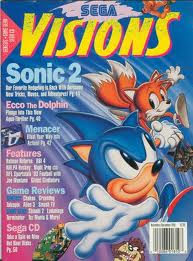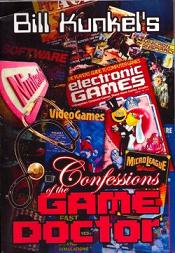It seems like there’s always been gaming magazines to cover the latest and greatest releases. Most of today’s gamers have never known a time when shelves weren’t chock full of magazines devoted to the hobby. Whether it’s stalwarts like GamePro or newcomers like Hardcore Gamer Magazine, there’s always plenty of great reading material on newsstands for the discerning gamer to rely on for the latest features and reviews.
 And do you know who we owe it all to? A man named Bill Kunkel. Often credited as the world’s first video game journalist, he was there when things first got started, and he set the standard for all who followed. I have to admit, he’s one of the trailblazers of the gaming press that so inspired me to get into writing about my favorite hobby. From those early, wondrous issues of Electronic Games, the first magazine ever published about gaming (which he helped found), to his great work on the short-lived Sega Visions, Kunkel has done it all. There isn’t a game journalist out there who doesn’t owe him big time, and Sega-16 had the honor of being able to chat with him about his time on Visions.
And do you know who we owe it all to? A man named Bill Kunkel. Often credited as the world’s first video game journalist, he was there when things first got started, and he set the standard for all who followed. I have to admit, he’s one of the trailblazers of the gaming press that so inspired me to get into writing about my favorite hobby. From those early, wondrous issues of Electronic Games, the first magazine ever published about gaming (which he helped found), to his great work on the short-lived Sega Visions, Kunkel has done it all. There isn’t a game journalist out there who doesn’t owe him big time, and Sega-16 had the honor of being able to chat with him about his time on Visions.
Sega-16: How did you come to be involved with Sega Visions?
Bill Kunkel: KKW was already consulting on Sega product at the time since SoA had access to pretty much everything SoJ had, but a lot of the games just weren’t appropriate for the U.S. market. I couldn’t believe it when they told me they were releasing Psycho Fox, a lame platform game that revolved around the Shinto religion. In any case, the relationship was there and when the Communique’ Group was hired to produce a slick company propaganda tool, they were directed toward us by Sega in terms of providing some content.
Sega-16: What were your functions, exactly?
Bill Kunkel: Really, we were just extremely well-paid contract writers. Communique’ ran the magazine. I think they mostly produced children’s magazines.
Let’s see, Joyce probably did the news (Game Gossip), I did the Game Doctor and Niles, while Arnie probably wrote a feature per issue. But we had no control over the content, really. Sega decided which game they wanted pushed in Niles Nemo each issue and we could never get any breaking news, advance looks at games, etc., so if you read Electronic Games or one of the other independent magazines, you already knew everything that was being pushed as news in SV.
Sega-16: How different was the experience from your time at Electronic Games?
Bill Kunkel: Oh completely. We were just hired hands at SV. We were being paid too well to rock the boat, but I never understood how Sega could delude itself into thinking that they would be able to sell this magazine (a $3.50 cover price appears on the slim first issue) on newsstands. Communique was producing an elaborate puff piece with a soupcon of credibility derived from the use of our names. Arnie dealt primarily with Communique’, who were very nice people, but were like parents producing a video game hype sheet for their kids.
 Sega-16: Sega Visions really tried to grow and developed over time, and was always put side by side with Nintendo Power. In your own opinion, how do you think it compared?
Sega-16: Sega Visions really tried to grow and developed over time, and was always put side by side with Nintendo Power. In your own opinion, how do you think it compared?
Bill Kunkel: Well, it failed, didn’t it? Whereas Nintendo Power remains a viable propaganda tool. The fact is that NP looked like a regular magazine, it didn’t look like a slick promotional item that no one was ever going to pay for. SV also contained about a tenth the material that NP had — it was never even a contest.
Sega-16: How much was Sega behind it?
Bill Kunkel: Sega liked the IDEA of having this magazine, and they were certainly willing to pay for it, but again, they never gave us any scoops, never gave us any material that couldn’t be obtained in other sources and never ran anything but favorable content with regard to its games. It was a hype sheet; that’s what Sega wanted, that’s what Communique’ designed and that’s what we wrote.
Sega-16: Sega tried at one point to charge for subscriptions but relented. Do you think that was a good idea?
Bill Kunkel: Relented? Hell yes, unless they wanted a readership in the hundreds. Nintendo’s great trick was in creating a magazine that didn’t constantly remind you that it was a tool for Nintendo; Sega Visions always looked — and read — exactly like what IT was, and people don’t spend money to buy company-produced magazines unless it’s part of a major club with prizes and pins and access to special content or they can convince people, as Nintendo did, that it was just another magazine — only the size of a small telephone book.
Sega-16: Was there anything else you wanted to see during the magazine’s run?
Bill Kunkel: Frankly, they were paying us so much money I just wanted to see it survive. But the constant push to create a saleable magazine out of a publication clearly created by the manufacturer to sell its software just didn’t fool anybody. I also felt that Communiqué was underestimating both the age and intelligence of the readers. No complicated words, simple plots on the comic strips (nothing surreal, despite the fact that the entire thing was surreal) all gave the magazine a rather “kindergarten” feel. And not even kids in kindergarten want that.
Sega-16: Do you think the decision to end the magazine had anything to do with the friction between Sega’s American and Japanese divisions?
Bill Kunkel: Probably; almost everything that happened in that company came down to that.
Sega-16: Tell us a bit about Niles Nemo, that pizza-loving Sega freak! How did he come to be?
Bill Kunkel: Sega wanted a comic strip and you know it was going to be one of those faux-superhero things — Captain Sega or somesuch. And I just wouldn’t do it, the idea repulsed and shamed me, even at those prices, but the strip also had to be two pages and you just can’t get much into two pages. So I developed Niles Nemo in Slumberland, which was like Little Nemo in Slumberland meets “Poochie” from the Simpsons. As with the original Nemo, Niles would order pizza from a “special” shop and when he ate it while playing a new Sega game, he fell into a deep sleep during which he was transported inside the game itself. I thought it was original and we did about six or so of them before Sega pulled the plug. I loved comic artist’s Dave Sullivan’s work — it’s the best thing about the series — but the whole thing about Niles being the “coolest kid in town” was just so ’50s. I just wanted him to be a gamer, but like I said, he became Poochie.
 Sega-16: We’re really excited about your new book, “Confessions of a Game Doctor.” Are there any Sega Visions anecdotes in there?
Sega-16: We’re really excited about your new book, “Confessions of a Game Doctor.” Are there any Sega Visions anecdotes in there?
Bill Kunkel: I don’t believe so. Although there are several Sega stories, in retrospect, Sega Visions was never anything more to me than a really well-paying gig where we were pretty much told what to cover, how to cover it and had no input into the visual presentation. This interview actually contains much more detail on the magazine than Confessions because I never really considered anything but Niles Nemo as especially worthwhile work and nobody really remembers Niles Nemo, so I guess he slipped through the cracks of gaming history.
We’re incredibly grateful for Mr. Kunkel’s candor and cooperation. For more information about his new book, head over to Rolenta Press and pick yourself up a copy. It’s great reading about the insides of gaming journalism from one of the true pioneers.

Recent Comments